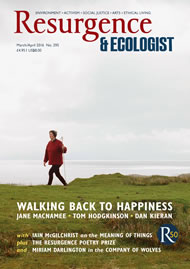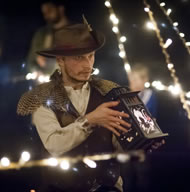“…the wolves have ways of arriving at your own hearthside.”
Angela Carter, The Company of Wolves
Amongst the shaggy vegetation, tree stumps, moss mounds and fern fronds of the Haldon Forest near Exeter, a group of anxious walkers pause and peer into the darkness. A nearly full moon is just breaking through the clouds. Our guide looms out of the trees. “We are nearing the boundary of the parish, and from here on it is not safe...” he announces as rain bursts out of a pitch-black sky. “Are you prepared for danger?”
“YES!” we chorus determinedly. I have been invited by Burn the Curtain, an innovative theatre company based in the South West of England, to immerse myself in the woods for a night of interactive adventure. Adapted by the company and playwright Shiona Morton, The Company of Wolves is a unique and exciting theatrical adventure for runners and walkers. The story taps into ancient folklore and such mythic fairytales as Red Riding Hood and Peter and the Wolf, as well as some of the writer Angela Carter’s stories – The Company of Wolves, Wolf-Alice and The Werewolf. In Burn the Curtain’s production, Red Riding Hood lives in a tiny village on the edge of dark and distant mountains. One night she puts on her red shoes and cloak and heads into the forest alone, watched by unseen eyes – and our nocturnal drama has begun.
For Angela Carter, whose career was cut short by her death from lung cancer in 1992, aged just 51, passivity was never a virtue. Humans were capable of change, and her provoking stories were concerned with survival, the ‘carnivore incarnate’, vivid symbolism, werewolf evocations and luxuriant, zestful imagery. The Red Riding Hood story lends itself perfectly to the woodland setting that Burn the Curtain’s production provides. Carter’s tale deals with, among other things, courage in the face of fear, getting into bed with the enemy, and a refusal to be repelled by what we have been told – not even a wolf’s teeth, lice and voracious appetite. This interactive theatre production might even trump Carter’s tale (disturbingly adapted for the cinema in Neil Jordan’s 1984 film), with its subversive immersion in the rebellious heroine’s story. “She knew she was nobody’s meat,” Carter wrote of her heroine, and so do we.
The group splits into hunters, who will run and chase after the wolf, and gatherers, who will walk and search for his scarlet-hooded bride. We follow paths through the woods and discover signs and clues along the way. Nobody knows what to expect, but it is one night away from Halloween, and we step through the portal of the forest ready for anything. It’s an exciting romp: the children are soaked, bright-eyed and bushy-tailed, but they are easily outnumbered by enthusiastic adults fully immersed in the playfulness of it all.
Perhaps we older ones are remembering what it was like to run through the woods with a band of friends. We stampede through wild Nature along increasingly narrow paths, imbibing cold air and rainfall; exhilarating and unpredictable turns take some of us into exploring our vulpine side, others to paths of righteousness. Voices and howling filter through the trees; we carry torches; we wipe the rain from our faces; we huddle together, form a circle, embody the joyousness of being out in the woods at night in the rain and wind. Infected with the fearless spirit of the heroine, her feminine strength and her empathy for the wolf, we pause on the side of a hill.
“There’s our village,” the Duke, one of the play’s narrators, says as we pause to catch our breath and gaze upon the far-off twinkle of the city. More of us come to the edge of the path to look. “There’s our home. We must protect it.” There is tenderness and urgency in his voice as we look down upon the city, our home, poignantly distant.
Before the evening starts, Joe Hancock, director at Burn the Curtain, told me: “We are challenging the traditional idea of what theatre might be. When the audience actively participates like this, the sense of communication is greater than [in] a traditional theatre space.” He’s right: as participants, we’re panting with the actors, looking into their eyes, interacting with them, sharing their fears and their questions, entirely implicated in the story. At the end, encircled in mystery and magic, rain-soaked and elated, we let go of the wolf-fear that drove us to run through the trees, away from the beasts in the shadows. Permeated by the wild elements of the forest, we form a community once more, and dare let rip a joyous howl at the great eye of the moon.
Traditional folk tales were used to frighten children into doing what they were told. Carter’s tale brought to the surface dark corners of the human psyche. Packed with symbolism as seductive as its language, she confronted convention and gender stereotypes and created a new story where roles are turned on their heads. Equally, Burn the Curtain’s Little Red Riding Hood is less vulnerable than the fairy-tale original, and carries a sharp knife. She is feisty and unafraid. What is so compelling about the story is that it enthrals the senses, physically immerses the body and mind, and engages empathy for the place, for the wolf, for community.
Now we have other wolves that prowl amongst us: the ‘Dark Web’, corporations, unchecked capitalism, poverty, terrorism, climate change. If we can subvert the wolf myth, is it possible to truly confront these threats without the emotional knee-jerk responses that lead to fear and destruction? How can going into the forest at night, running through the trees, become a metaphor for something so much bigger? But it did.
On my way home, drenched and purified by the forest air, I thought of what most threatens our communities now. The way the evening had been described, where wolves will be coming for us out of the dark, had filled me with a sense of discomfort and unease. But Burn the Curtain’s theatrical re-enactment of the old story, as spellbinding as stepping inside the pages of a fairy tale, or a dark dream, left me thoughtful. I was taken by surprise by how gentle the woods at night were, by how little I was afraid of the dark. The trees were a solid presence, towering softly and dripping with wet. It rained so heavily, while we made our way through winding paths, around stumps, over roots, through puddles, that there was nowhere to shelter. Slugs were lit up in our torch beams, owls flitted away from the commotion, and all the time glowing red eyes of the wolf flickered and burning torches appeared and disappeared.
How humans love to imagine, to play, to re-enchant our home. How enthusiastic everyone was about joining in with the story, about creating community, protecting ourselves with a ring of fire, huddling together for comfort. In the end, if our hand is forced and we are required to choose between compassion and revenge, which of these opposing energies will be allowed to prevail?
Immersed in the pungent and living woods, in the rain and the dark, we are watchful, attentive. So what if we choose compassion, this play asks, what if we allow the wolf to coexist with us? How will that be? Without him, would we still be wholly human? If what we need is an ecologically harmonious sense of self in the world, then the Red Riding Hood story, which raised a false separation between human and wild, needs to be addressed now more than ever, and the question asked: why are we continuing to stamp on the wild without us and within us, destroying our own habitat and home? Don’t we need all other species? Are they not our life-support system, no matter how uncomfortable or expensive it may seem to cohabit with them?
In his book Of Wolves and Men, the American Nature writer Barry Lopez observes that the wolf’s movement through the woods is reminiscent of the movement of flowing water or of shifting shadows. Its effortless drift through the trees at night is like a floating dream. This geography has always been within us as well as without; it is what makes us human, and from the time our ancestors first reimagined the wolf in the caves at Lascaux and elsewhere, we have known that there is more to hunting than killing, and that we have more in common with wolves than we would sometimes like to admit. That connection of the psychological landscape of home, infused with reverence for wildness as well as fear of it, incorporates the company of wolves with tenderness and community. Compassion and empathy with the wild without and the wild within could be the very thing that saves us.
Burn the Curtain’s production of The Company of Wolves is touring Britain in 2016:
Cwmcarn Forestry, Caerphilly, South Wales 7 to 9 April
Durlston Country Park, near Swanage, Dorset 21 to 23 April
Delamere Forest, near Frodsham, Cheshire 5 to 7 May
For a full list of dates and more information see the website: www.burnthecurtain.co.uk








